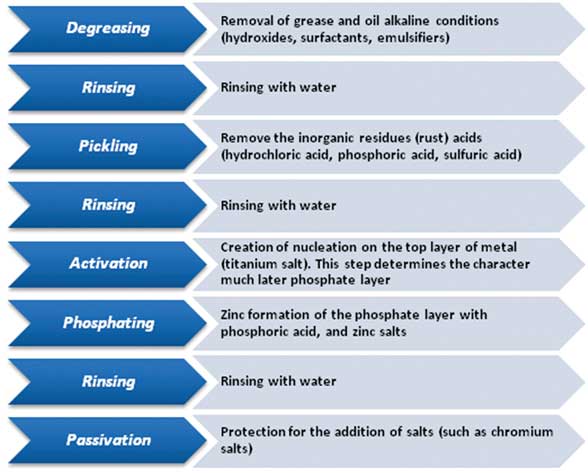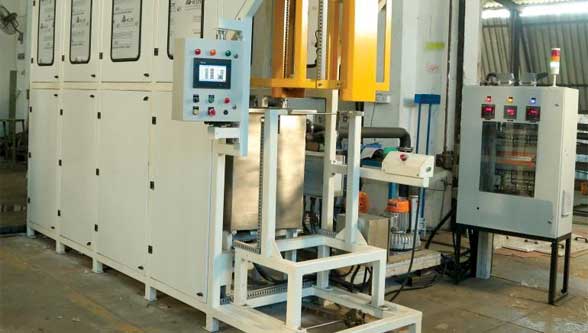by Gala Precision Technical Team
Q. What Is the phosphating Process?
Phosphating is the process of converting a steel surface to iron phosphate. This is mostly used as a pretreatment method in conjunction with another method of corrosion protection. A layer of phosphate coating typically includes iron, zinc or manganese crystals.
Phosphating is a chemical process for treating the surface of steel, where barely soluble metal-phosphate layers are formed on the base material. The layers created are porous, absorbent and suitable as a conversion layer for subsequent powder coating without further treatment.
Q. Why is phosphating done?
The process of Phosphate coating is employed for the purpose of pretreatment prior to coating or painting, increasing corrosion protection and improving friction properties of sliding components. Metal coating offers both zinc phosphate and manganese phosphate coating. Manganese phosphate coating is applied when wear resistance and anti-galling properties are required. Manganese phosphate also possesses the ability to retain oil, which further improves anti-friction properties and imparts corrosion resistance to the coated parts. Zinc and manganese coatings are used to help break in components subject to wear and help prevent galling. Most phosphate coatings serve as a surface preparation for further coating and/or painting, a function it performs effectively with excellent adhesion and electric isolation.

Q. Why is phosphating done before powder coating?
The process of phosphating aluminum and steel parts is typically listed as a conversion coating because the process involves metal removal as part of the reaction. However, it is not like anodizing or black oxide in that the phosphate coating is actually a precipitation reaction.
Q. How many types of phosphating are there?
3 Types of Phosphating. Phosphating is a conversion coating applied to Steel and Iron components. In its basic form, the process involves immersing a component in a dilute solution, which converts the surface of the metal into a layer of microscopic Phosphate Crystals.
Q. How does phosphate prevent corrosion?
Corrosion resistance and resistance to detergents are also higher when compared to Zinc Phosphate. Appearance is gray. Manganese Phosphate: Used primarily on friction and bearing surfaces to prevent meal-to-metal contact and reduce wear. This coating is also used as a base for dry film lubricants. The following is a typical phosphating procedure: Cleaning the surface, Rinsing, Surface activation, Phosphating, Rinsing, Neutralizing rinse (optional), and Drying.

Q. What are the main applications of phosphating?
- The main applications of phosphating are:
- Corrosion protection in conjunction with organic coatings, such as paints and polymer films
- Facilitation of cold-forming processes, such as wire drawing and tube drawing, or deep drawing
- Corrosion protection in conjunction with oils and waxes
- Corrosion protection with no subsequent treatment
- Improving anti-friction properties, such as break-in, wear resistance, anti-galling and coefficient of friction
- Providing strong adhesion bonding for subsequent painting or other organic coating
Q. What are the highlights and salient features of Gala’s Phosphating Plants?
The phosphating process comprises alkaline degreasing, water rinsing, activation, manganese phosphate application, water rinsing again, protective oiling and then drying in that sequence.
Gala’s multi-stage phosphating plants are compatible for use with all modern phosphate formulations with multiple process stages to include degreasing / phosphating and multiple rinse cycles. Ideal for batch processing, these units are operator-friendly with easy-to-use control systems to set independent fluid tank temperatures and cycle times. The component basket is rolled from the wash machine on to an external fixed or mobile platform for easy loading and unloading of the components. Corrosion resistant electric immersion heaters and stainless steel wash pump are fitted as standard accessories. Sturdy construction with thick thermal insulation, heavy duty stainless steel component basket, component holding jigs, fully independent fluid tanks, low fluid level protection, integral fluid filtration network, electric heating, load / unload station, auto fresh water refill in rinse tanks and digital display fluid temperature control are some of the prominent features of this totally PLC controlled system.
Gala also offers the following optional extras with the system: Hot wash, rinse, air knife & dry cycles to suit the application; Disc type oil skimmer; Fine inline fluid particle filtration; Oil / water separator units; Effluent transfer pump; Steam extraction fan & condenser units; Auto dosing units and DI water plant. Gala Precision Engineering is a leader in disc springs, assemblies and surface engineering solutions in India. The company designs and manufactures integrated systems for mass finishing, washing & cleaning for a wide range of applications in automotive, defense and general engineering segments.

For more information,
Website: www.galagroup.com



